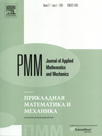 | | Journal of Applied
Mathematics and Mechanics
Russian Academy of Sciences | | Founded
in January 1936
(Translated from 1958)
Issued 6 times a year
ISSN 0021-8928
(print version) |
Archive of Issues
| Total articles in the database: | | 10610 |
| In Russian (ΟΜΜ): | | 9811
|
| In English (J. Appl. Math. Mech.): | | 799 |
|
| << Previous article | Volume 77, Issue 4 / 2013 | Next article >> |
| S.A. Lychev and A.V. Manzhirov, "The mathematical theory of growing bodies. Finite deformations," J. Appl. Math. Mech. 77 (4), 421-432 (2013) |
| Year |
2013 |
Volume |
77 |
Issue |
4 |
Pages |
421-432 |
| Title |
The mathematical theory of growing bodies. Finite deformations |
| Author(s) |
S.A. Lychev (Moscow, Russia, lychevsa@mail.ru)
A.V. Manzhirov (Moscow, Russia) |
| Abstract |
The fundamentals of the mathematical theory of accreting bodies for finite deformations are explained using the concept of the bundle of a differentiable manifold that enables one to construct a clear classification of the accretion processes. One of the possible types of accretion, as due to the continuous addition of stressed material surfaces to a three-dimensional body, is considered. The complete system of equations of the mechanics of accreting bodies is presented. Unlike in problems for bodies of constant composition, the tensor field of the incompatible distortion, which can be found from the equilibrium condition for the boundary of growth, that is, a material surface in contact with a deformable three-dimensional body, enters into these equations. Generally speaking, a growing body does not have a stress-free configuration in three-dimensional Euclidean space. However, there is such a configuration on a certain three-dimensional manifold with a non-Euclidean affine connectedness caused by a non-zero torsion tensor that is a measure of the incompatibility of the deformation of the growing body. Mathematical models of the stress-strain state of a growing body are therefore found to be equivalent to the models of bodies with a continuous distribution of the dislocations. |
| Received |
03 February 2013 |
| Link to Fulltext |
|
| << Previous article | Volume 77, Issue 4 / 2013 | Next article >> |
|
 If you find a misprint on a webpage, please help us correct it promptly - just highlight and press Ctrl+Enter If you find a misprint on a webpage, please help us correct it promptly - just highlight and press Ctrl+Enter
|
|

 Russian
Russian  English
English